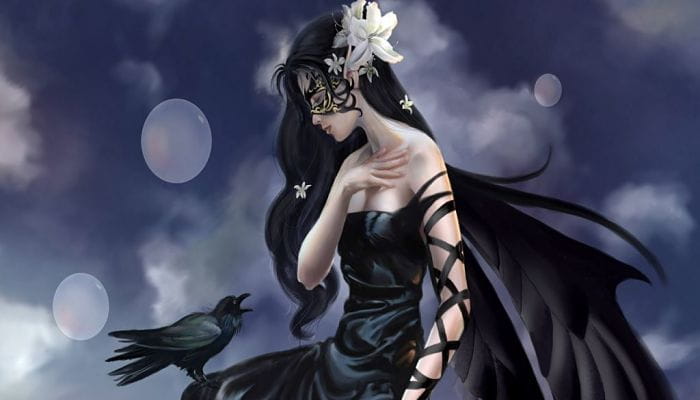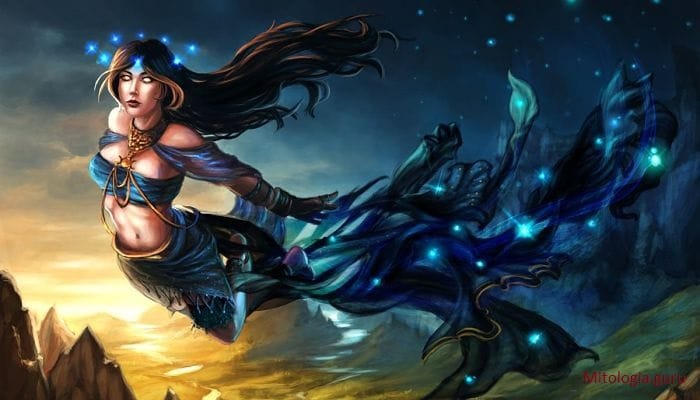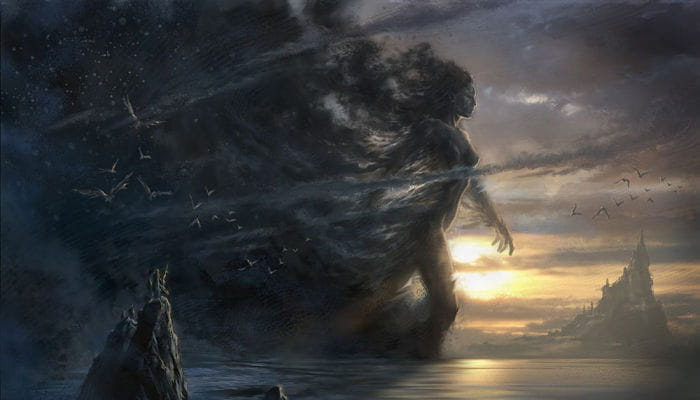The pantheon of Ancient Greece contained hundreds of deities, and while today the most famous of these deities are those based on Mount Olympus, there was a whole plethora of deities that preceded Zeus and Poseidon. One of these earlier deities was the goddess Nyx, a “dark” goddess, one associated with the night, and a powerful one at that.
Who was Nyx?

She was the goddess of night, one of the primordial gods (protogenoi) who emerged as the dawn of creation. She was the daughter of Chaos (Air) and, together with Erebus (Darkness), produced Aither (Aether, Light) and Hemera (Day). She alone gave birth to a brood of dark spirits, including the three Fates, sleep, death, struggle, and pain.
She was an ancient deity who was generally considered the very essence of night: a veil of dark mists drawn across the sky to obscure the light of Aither, the bright blue of the sky. Her opposite number was Hemera (Day), who dispersed the mists of night at dawn. In ancient art, she was depicted as a winged goddess or a charioteer, sometimes crowned with a halo of dark mists.
Birth
She is the Greek goddess of night and the daughter of Chaos. She was said to be very beautiful. Her birthplace was not on Earth but in Gaia. She is a Primordial Goddess. It is said that she was created near the beginning of time. Her home is in the depths of Hades’ underworld. She has a shadowy figure, making her the perfect personification of night. In ancient art, Nyx was depicted in three different ways. She was either winged or crowned with a halo of dark mists.
Marriage
She married Erebus, the God of Darkness. Nyx and Erebus produced Hemera (Day) and Aither (Light). Hemera is the opposite of Nyx. She brought the dark veil over the night, while Hemera chased away the dark mists every morning. Interestingly, she was able to create her own dark spirits, including Fate, Sleep, Death, Strife, and Pain. Other children of Nyx include Geras, Moros, Nemesis, the Keres, and the Oneiroi.
Other children of Nyx
Aether and Hemera (and Hypnos) were not the only children of Nyx, as Hesiod would mention a whole series of other deities, many of whom were dark in nature. Among the children of Nyx were Thanatos (Death), twin brother of Hypnos, Eris (Strife), Geras (Old Age), Moros (Doom), Nemesis (Retribution), and also groups of deities, the Moirai (Fates), the Keres (Hounds of Hades), and the Oneiroi (the gods of dreams).
The Protogenoi Nyx

According to Hesiod’s Theogony, she was one of the Protogenoi, the first primordial gods of the Greek cosmos. As such, Nyx was considered the daughter of the goddess Chaos, the first of all deities. Nyx effectively became the goddess of Night, and was depicted as a beautiful woman, dressed in black, surrounded by mist, and often accompanied by some of her numerous children.
In the most common timeline of Greek mythology, Nyx was associated with Erebus (darkness), and they would produce children also called Protogenoi, Aether, and Hemera. In contrast, Aether and Hemera, as Light and Day, were the opposite of their parents, Night and Darkness.
Nyx’s Ability
She is a unique goddess. She can impact humanity in a good or bad way. Her ability is to bring sleep or death to the human race. This is not a goddess to mess with. Zeus even feared Nyx because she was older and stronger than him. She was the only goddess he feared. That says a lot about her power. The moonstone is used to honor her to this day. It reflects its owner and must be worn during the full moon.
Where the goddess lived
She lived in Tartarus, a place of torment, suffering, and darkness. Interestingly, however, Nyx is not exactly the personification of evil in Greek mythology. She has never spoken of doing anything more “evil” than Zeus himself in any mythology. However, due to her mysterious and dark nature, many see her as a more villainous figure than she appears to be. Surprisingly, Nyx was never the main figure of any cult or group, but was revered as a background deity in many of the other gods and goddesses.
Myths of the goddess

Nyx in the underworld
Nyx resided in the depths of Tartarus, in the dark recesses of the Underworld, and it was said that the dark, misty air that swirled around Tartarus was Erebus. Many of the other dark deities of Ancient Greece also resided there.
Every night she would emerge from her cave within Tartarus, and with Erebus, she would block the light emitted by Aether, bringing night and darkness to the world. The next morning, Hemera would emerge from Tartarus and sweep away the darkness of the night, and Nyx would return to her dwelling. Thus, mother and daughter were never in the same place at the same time.
In later Greek mythology, characters such as Eos (Dawn), Helios (Sun), and Apollo would replace the roles of Aether and Hemera, but Nyx herself was never subjugated, an indication of the esteem in which the powerful goddess was held.
Nyx and Zeus
He is not noticeable as a central figure in many of the mythical tales, but that does not mean he was not present. An interesting story took place between Nyx’s son, Hypnos, and Zeus. Hera, Zeus’s wife, goddess of birth and marriage, asked Hypnos to put Zeus to sleep. She was trying to conspire against him while he slept.
The plan did not end well. Hypnos was not strong enough to incapacitate Zeus. When he found out, he hunted Hypnos down. Nyx allowed her son to take refuge in her cave. Zeus was too afraid to anger her, so he retreated to where he had come from.
She appears in many important Greek poems. In the fragments of poetry she inhabits, Nyx is the first of all creation. Before there was anything, there was darkness or “night,” and it was there that Nyx came into existence, according to ancient Greek myth. Nyx is often represented in symbolism as a moon or stars, in accordance with the fact that she ends the day and brings night.

